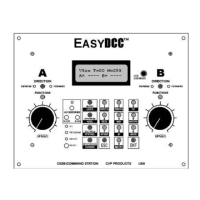103
Fine Tuning Locomotive Performance
By using MainTrack or "OPS " programming, fine tuning locomotive motion performance is
relatively easy. With the push of a few buttons, a locomotive decoder’s running characteristics
can be quickly changed. The changes take effect immediately so the locomotive can be tested to
confirm the desired result has been achieved.
Since each locomotive has unique running characteristics, plan on a little trial and error
experimentation. Try different options and values. Decoders CAN NOT BE HARMED. Modern
decoders can always be reset back to their original factory defaults - just in case.
Decoder Requirements
Check your decoder manual to insure it supports OPS MODE programming; most modern
decoders do. Look for phrases such as OPS MODE PROGRAMMING, MAINTRACK
PROGRAMMING or DIRECT ADDDRESSING. Decoders that do not support OPS MODE
programming, cannot accept reprogramming commands while on the mainline. If you are not
sure, contact the decoder manufacturer and ask them.
Fine-tuning Options And Definitions
Most modern decoders offer an “on-the-fly” adjustment of their internal standard speed table.
This is not the same as downloading a new speed table. Instead, there are 3 primary CVs that
control the actual speed versus throttle setting. These can all be modified using OPS
Programming. The graph on the next page diagrams what happens to the resultant motor speed as
these variables are changed.
CV2 sets the motor starting voltage (MSV) of the motor voltage that corresponds to speed step
1 (in a 28 speed step setting). This is the first speed step from off, or zero voltage. You can decide
if you wish the motor to be moving at a good rate of speed or just barely moving by changing the
MSV. A small MSV value means only a small extra increase in motor voltage. A larger MSV
value means the motor receives a higher motor voltage.
CV6 sets the midpoint motor voltage at the throttle midpoint setting which corresponds to
speed step 14 (in a 28 speed step setting). If a lower half speed is needed, for example in speed
matching application, set CV6 to a smaller value. Speed curve #3 lowers the half speed to 55. So
at speed step 14, the locomotive is running at 25% of the maximum motor voltage. Conversely, if
the locomotive is running too slow at speed step 14, CV6 can be raised to increase the half speed.
CV5 sets the motor’s top speed which corresponds to speed step 28 (in a 28 speed step setting).
If a lower top speed is needed, for example in speed matching application, set CV5 to a smaller
value. Speed curve #2 lowers the top speed to 155. So at speed step 28, the locomotive is running
at 60% of the maximum motor voltage.
Setting CV5 to a value less than CV6 is OK but the resultant speed curve will be an
upside down V. Curve #5 on the previous page shows the extreme case with CV5
equal 0 and CV6 equal to 128, The motor will reach top speed at step 14 and then
gradually slow down to a stop at step 28. Any of the following motion performance
configuration variables (CV) may be used, alone or in combination, to change how
a locomotive responds to throttle commands: Motor Starting Voltage (MSV),
Acceleration (Inertia) delay (ACCL), Deceleration (Momentum) delay (DECL),
which Speed Table is Used (SPDTABL), and loading a new Alternate Speed Table.
As always, consult your decoder manual for more details and to check for other performance
CVs that may be available.
ACCL [CV#3] - This determines the rate of change of speed upon an increase in throttle speed.
Higher values result in slower rate of change - more inertia. For example with a very high value,
moving the throttle from OFF to mid-range, will result in the locomotive not moving for a very
long time, and when it does begin moving, its speed increase will be extremely gradual.

